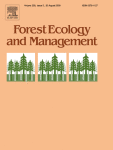Ver ítem
- xmlui.general.dspace_homeCentros Regionales y EEAsCentro Regional Patagonia NorteEEA BarilocheArtículos científicosxmlui.ArtifactBrowser.ItemViewer.trail
- Inicio
- Centros Regionales y EEAs
- Centro Regional Patagonia Norte
- EEA Bariloche
- Artículos científicos
- Ver ítem
Ring density record of phenotypic plasticity and adaptation to drought in Douglas-fir
Resumen
Microdensity profiles of Douglas-fir’s clones and weather data were used to study phenotypic plasticity (dendroplasticity). Within-ring microdensity was interpreted as the variation of tree response to drought constraints during selected growing seasons. An original norm of reaction was obtained by pairing evident points of abrupt changes in tree-ring microdensity profiles and in weather indices. The coefficients of the non-linear models adjusted to the
[ver mas...]
Microdensity profiles of Douglas-fir’s clones and weather data were used to study phenotypic plasticity (dendroplasticity). Within-ring microdensity was interpreted as the variation of tree response to drought constraints during selected growing seasons. An original norm of reaction was obtained by pairing evident points of abrupt changes in tree-ring microdensity profiles and in weather indices. The coefficients of the non-linear models adjusted to the reaction norms were analysed as dendroplasticity variables. Dendroplasticity variables were significantly different between geographical locations, years and clones. Heritability of the dendroplasticity variables ranged from low to high and was similar to heritability values of microdensity variables such as mean ring density (MRD). Coefficients of genetic variation of dendroplasticity variables were intermediate between those of wood density and growth variables. Dendroplasticity variables were phenotypically and genetically related to ring microdensity variables, more strongly to latewood variables. Dendroplasticity provides retrospective, synthetic and easy-to-interpret information about tree response to the variation of the balance between water availability and water demand during the growing season. The proposed model of dendroplasticity is
described by a number of parameters that are linked to a biological meaning. Our results suggest that there is a potential for adaptation to drought in Douglas-fir, with two mechanisms involved: at individual level, short-term plastic response during the growing season and, at population level, longterm, between-generation, evolution process.
[Cerrar]

Autor
Martinez Meier, Alejandro;
Sanchez, Leopoldo;
Dalla Salda, Guillermina;
Gallo, Leonardo Ariel;
Pastorino, Mario Juan;
Rozenberg, Philippe;
Fuente
Forest ecology and management 258 (5) : 860–867. (Agosto 2009)
Fecha
2009-08
Editorial
Elsevier
ISSN
0378-1127
Formato
pdf
Tipo de documento
artículo
Palabras Claves
Derechos de acceso
Restringido
 Excepto donde se diga explicitamente, este item se publica bajo la siguiente descripción: Creative Commons Attribution-NonCommercial-ShareAlike 2.5 Unported (CC BY-NC-SA 2.5)
Excepto donde se diga explicitamente, este item se publica bajo la siguiente descripción: Creative Commons Attribution-NonCommercial-ShareAlike 2.5 Unported (CC BY-NC-SA 2.5)

